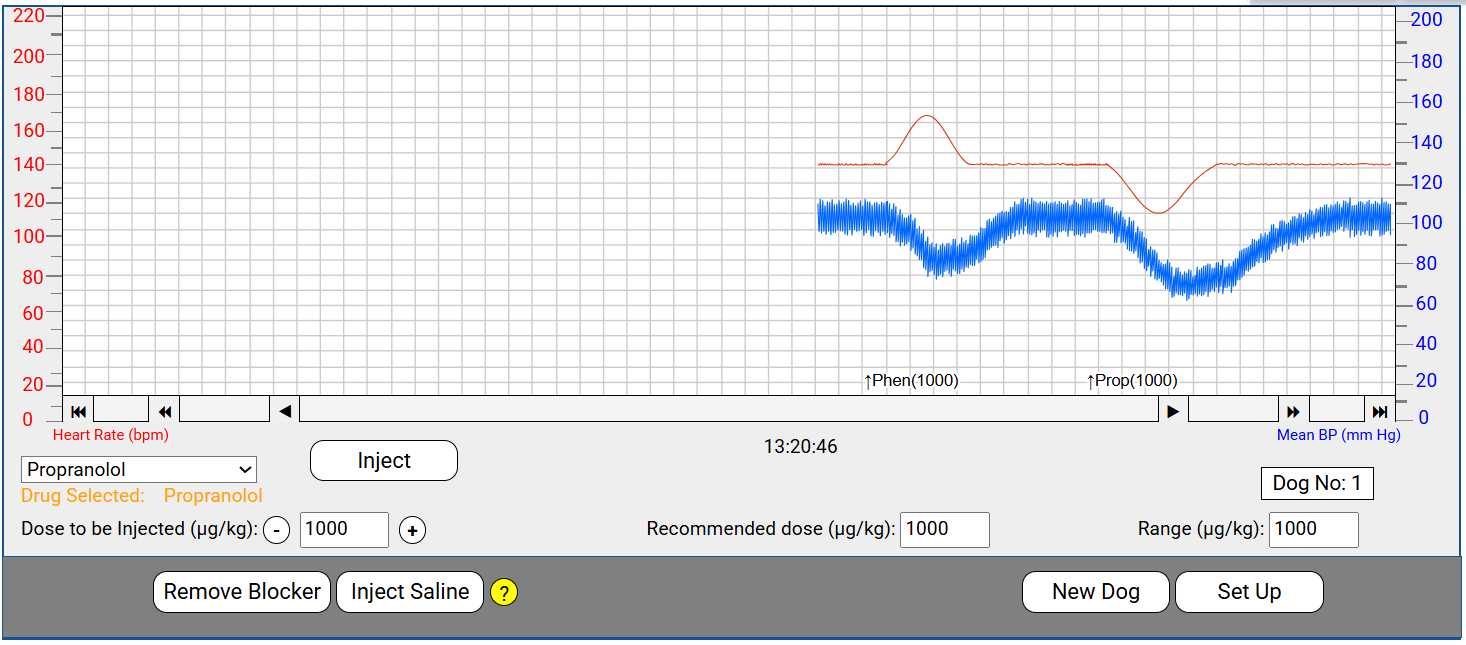Effect of Drugs on Blood Pressure (BP) and Heart Rate (HR) of Dog
Dogs are widely used as laboratory models in the field of pharmacology because their cardiovascular physiology closely resembles that of humans. This experiment allows students to see pharmacodynamics of drugs like Epinephrine, Norepinephrine, Isoprenaline, Acetylcholine, Histamine, Phentolamine, Atropine, and Propranolol in a real-time setting. It supports the theoretical teachings provided in autonomic nervous system pharmacology and demonstrates the adrenergic receptors and cholinergic receptors' function in regulating blood pressure (BP) and heart rate (HR).
Besides dog experiments, pharmacology students also learn about bioassay experiments, the rabbit eye experiment, and contemporary practices like drug safety monitoring, all of which shape a balanced view of drug action.
Aim of the Experiment
The main aim is to learn about the pharmacological action of drugs on the blood pressure and heart rate of an anesthetized dog. It also shows reflex tachycardia, reflex bradycardia, baroreceptor reflex, and the effects of sympathomimetic drugs, parasympathomimetic drugs, adrenergic blockers, and anticholinergics.
Materials and Experimental Setup
- Animal model: Healthy adult dog
- Anesthetic drug: Sodium pentobarbitone (25 mg/kg IV)
- Equipment: Tracheal cannula, carotid artery cannula, venous cannula, pressure manometer or data acquisition system
- Media: Heparinized saline (anticoagulant)
- Drugs used in pharmacology: Isoprenaline, Acetylcholine, Atropine, Propranolol, Histamine
- This type of setup is also discussed during the Workshop on Basic Biostatistics (MyCalPharm’s new feature), where students learn not only how to conduct experiments but also how to analyze and interpret the results statistically.
Experimental Procedure
- Anesthetize the dog to induce surgical anesthesia.
- Cannulate the trachea to maintain airway.
- Cannulate the carotid artery and attach to the BP recording system.
- Cannulate a vein to give IV drugs.
- Record the baseline blood pressure and heart rate.
- Give drugs sequentially with sufficient washout periods.
- Observe the pharmacological effect - systolic BP, diastolic BP, mean arterial pressure, and HR changes.
Observations and Results

When we combine Phentolamine and Propranolol the outcome is presented below:
For BP: phases 1 & 2 are abolished, and baseline BP for all phases becomes visible.
For HR: phases 1 & 2 are abolished, and baseline HR for all phases becomes visible.
Discussion
This experiment of pharmacology illustrates main principles:
- α-adrenergic receptor stimulation → vasoconstriction, BP increase.
- β1 receptor stimulation → increased HR and contractility
- β2 receptor stimulation → vasodilation, BP decrease.
- Muscarinic receptor activation → bradycardia, hypotension
- Autonomic antagonists (atropine, propranolol) → blockade of parasympathetic or sympathetic blockade
Students also learn about pharmacodynamics, dose-response relationships, receptor selectivity, and baroreceptor reflex. These topics provide the foundation for the understanding of antihypertensive drugs, cardiac stimulants, vasopressors, and antiarrhythmic drugs.
Clinical Significance
The observations from this dog blood pressure experiment are closely linked to clinical pharmacology:
- Noradrenaline is employed as a vasopressor in shock.
- Adrenaline saves lives in anaphylaxis and cardiac arrest.
- Atropine is given in bradyarrhythmia.
- Propranolol is used as an antihypertensive and antianginal agent.
Ethical and Modern Considerations
Though these classic experiments continue to be taught, most institutions have transitioned to virtual pharmacology labs, computer simulations, and video demonstrations. This move makes the experiments more ethical while still retaining their learning value. MyCalPharm is also leading in the same area by integrating bioassay experiments, rabbit eye experiment simulations, and statistical analysis workshops to provide students with an all-round learning experience.
Conclusion
Drugs' effect on blood pressure and heart rate in dog experiments is the basis of experimental pharmacology. It is the core of the study of autonomic pharmacology, receptor physiology, and drug action. In spite of the shift towards simulation teaching, these experiments are still essential for veterinary, medical, and pharmacy students. By incorporating current tools like drug safety monitoring and statistical workshops, the learning experience becomes ethical and comprehensive.
